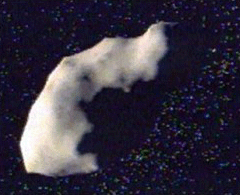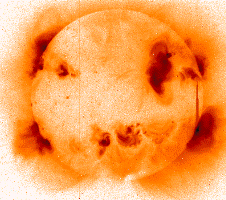Near Earth Asteroid Reaches Highest on Hazard Scale
2005 02 05
by Mitch Battros – ECTV
 A recently rediscovered 400-meter Near-Earth Asteroid (NEA) is predicted to pass near the Earth on 13 April 2029. This week, NASA scientists used new observations from the Arecibo Observatory to further pin down the track of 2004 MN4. The flyby distance is uncertain and an Earth impact cannot yet be ruled out (NASA). The odds of impact, presently around 1 in 300, are unusual enough to merit special monitoring by astronomers, but should not be of public concern. These odds are likely to change on a day-to-day basis as new data are received. It is hopeful, the possibility of impact will eventually be eliminated as the asteroid continues to be tracked by astronomers around the world. A recently rediscovered 400-meter Near-Earth Asteroid (NEA) is predicted to pass near the Earth on 13 April 2029. This week, NASA scientists used new observations from the Arecibo Observatory to further pin down the track of 2004 MN4. The flyby distance is uncertain and an Earth impact cannot yet be ruled out (NASA). The odds of impact, presently around 1 in 300, are unusual enough to merit special monitoring by astronomers, but should not be of public concern. These odds are likely to change on a day-to-day basis as new data are received. It is hopeful, the possibility of impact will eventually be eliminated as the asteroid continues to be tracked by astronomers around the world.
The brightness of 2004 MN4 suggests that its diameter is roughly 400 meters (1300 feet) and our current, but very uncertain, best estimate of the flyby distance in 2029 is about twice the distance of the moon, or about 780,000 km (480,000 miles). On average, an asteroid of this size would be expected to pass within 2 lunar distances of Earth every 5 years or so.
Most of this object's orbit lies within the Earth's orbit, and it approaches the Sun almost as close as the orbit of Venus. 2004 MN4's orbital period about the Sun is 323 days, placing it within the Aten class of NEAs, which have an orbital period less than one year. It has a low inclination with respect to the Earth's orbit and the asteroid crosses near the Earth's orbit twice on each of its passages about the sun.
Something Wicked Cometh Our Way---Continues
2005 02 05
 Watch for an upcoming report on the Sun, to be distributed Sunday night. There are some sitting high atop NASA/NOAA’s pyramid who are less than at ease with possible coming events related to very dangerous solar activity. Watch for an upcoming report on the Sun, to be distributed Sunday night. There are some sitting high atop NASA/NOAA’s pyramid who are less than at ease with possible coming events related to very dangerous solar activity.
I hope to have Dr. Ernest Hildner, Director of the NASA/NOAA Space Weather Center “on record” by next Tuesday’s show. You may recall the last two times I had Hildner on the show, the last of which was November 4th 2003. While “on-air”, you could hear Dr. Hildner reading the solar instruments during our interview. Then out of nowhere you hear Hildner say “Oh my gosh, it’s off the scale”. Radio has never been so good to me! As a talk show host, one can only dream of such a candid response.
November 4th 2003 was the day that made history. It was the largest solar flare every recorded. It is estimated to have reached an X45-Class flare. Now remember, I say “in recorded history”. Paleo-sciences clearly show us the Earth has seen this many times before. What makes this even more exhilarating (and scary), is the fact that when this solar flare was unleashed, the sunspot region had already rotated around the western limb.
More coming!!!!
Article From: http://www.earthchangestv.com/secure/2005/article_6765.php

|
